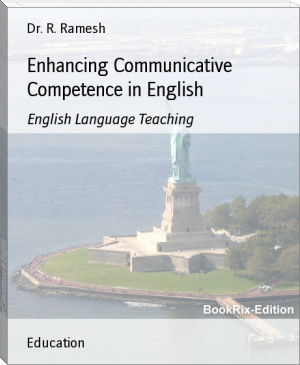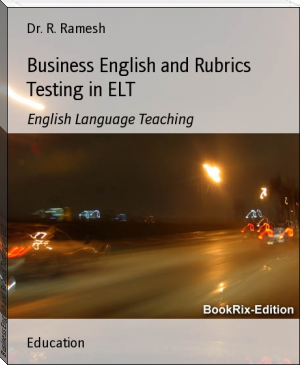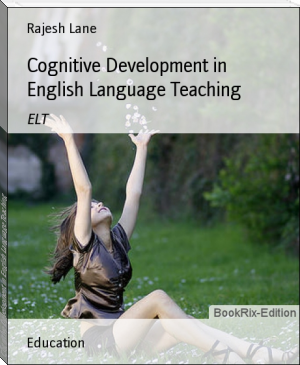Communicative Competence in English by Dr. R. Ramesh (best ereader manga TXT) 📖

- Author: Dr. R. Ramesh
Book online «Communicative Competence in English by Dr. R. Ramesh (best ereader manga TXT) 📖». Author Dr. R. Ramesh
Reform movement in Direct Methods laid foundation for the development of British Approach, which was later evolved as Audio-lingualism in United States and Oral Approach or Situational Language Teaching in Britain.
II. Nature of Approaches and Methods in Language Teaching
Theories of psychology, philosophy and linguistics greatly influenced the reform movements in language during nineteenth century. Study of teaching methods and procedures in language teaching gained a central role in applied linguistics. Linguists have made various attempts to conceptualize the nature of methods and explore the systematic relationship between theory and practice within a method.
In 1963, American applied linguist Edward Anthony proposed three levels of conceptualization and organization which he termed as approach, method and techniques. He arranged it in a hierarchical order. In his term it can be argued that, techniques carryout a method which is consistent will be known as an approach. “An approach is a set of correlative assumptions dealing with the nature of language teaching and learning” (Richard and Rogers 15). It is axiomatic and describes the nature of subject matter to be taught. “Method is an overall plan for the orderly presentation of language material, no part of which contradicts and all of which is based upon the selected approach” (Richard and Rogers15). A method is procedural and based on selected approach. “Technique is implementational. It must be consistent with a method and therefore in harmony with an approach as well” (Richard and Rogers 15).
1. Approach: An approach refers to the theories about nature of language and language learning.
a .Theory of Language
Three different theoretical views about language formed the basis of current approaches and methods in language teaching. They are, Structural View, Functional View and Interactional View.
i. Structural View
It is the most traditional view of language which treats language as a system of structurally related elements for the coding of meaning. Audio-lingual method, Total Physical Response and Silent Way support this view of language.
ii. Functional View
It views language as a vehicle for the expression of functional meaning. If emphasizes semantic and communicative diamensions of language. This view originated from the communicative movement in language. Wilkin’s Notional Syllabuses (1976) revealed the implications of this view of language for syllabus design. The movement of English for Specific Purpose [ESP] originates from functional view of language needs.
iii. Interactional View
Language as a vehicle of interpersonal relations is the focal point of this view. Language is considered as a tool for the creation and maintenance of social relations. It includes interaction analyses, conversation analysis and ethno methodology.
b. Theory of Language Learning
Methods of teaching are evolved primarily from theory of language learning.
A learning theory underlying an approach or method respond to two questions 1. What are the psycholinguistic and cognitive processes involved in language learning? 2. What are the conditions that need to be met in order for these learning processes to be achieved? Learning theories associated with a method at the level of approach may emphasize either one or both of these dimensions. Process oriented theories built on learning processes such as habit formation, induction, inferencing, hypothesis testing and generalization. Condition oriented theories emphasize the nature of human and physical context in which language learning takes place.”(Richard and Rogers18)
Stephen D.Krashen’s ‘Monitor Model of Second Language Development’, Tracy D. Terrell’s ‘Natural Approach’, Charles. D.Curran’s ‘Counseling-Learning’, James Asher’s ‘Total Physical Response’, and Caleb Gattegno’s ‘Silent Way’ are examples for methods which are developed from learning theories.
2. Design A Design links theory with practice or an approach with procedure. It is a level of method analysis. It includes
a. Objectives of methods b. How language content is selected and organized within a method. c. Type of teaching and learning activities in a method. d. Role of learners e. Role of teacher f. Role of instructional materials.
3. Procedure
This is the last level of conceptualization and organization with in a method. There are three dimensions of a method at the level of procedure.
a. Use of teaching activities to present new language. b. The way in which the teaching activities are used. c. The procedures and techniques used for giving feedback to the learners.
III. Oral Approach and Situational Language Teaching
Oral Approach was developed by British applied linguists during 1930-1960s. Main proponents of this movement were Harold Palmer and A.S. Hornby. They have attempted to develop a scientific foundation for an Oral Approach to teaching English. In 1950s Oral Approach become an accepted British Approach to English language teaching. Main characteristics of Oral Approach are, 1. Language teaching starts with spoken language. 2. Target language is used as the medium of instruction in class room. 3. New language points are introduced situationally. 4. Grammatical items are graded from simple to complex. 5. Reading and writing are introduced only after the learner is through with sufficient lexical and grammatical basis.
Situational Language Teaching was based on the behaviorist habit-learning theory. It aims at developing good practical command over the four basic skills of language. These skills are practiced by using structures which are linked to a situation. “Speech was regarded as the basis of language and structure was viewed as being at the heart of speaking ability” (Richard and Rogers 35). “Guided repetition, and substitution activities, including chorus repetition, dictation, drills and controlled oral based reading and writing task” (Richard and Rogers 38) are same of the techniques used for developing language skills.
IV. Audio lingual Method
Audio lingual method was developed by professors of American Universities as a language programme for military personnel at the time of world war-II. This method is also known as Army Specialized Training Programme [ASTP]. This Programme was brought out as a combination of structural linguistic theory, aural-oral procedures and behaviorist psychology. The term ‘audiolingualism’ was coined by Prof. Nelson Brooks in 1964.
Brooks distinguished two types of objectives for language learning. They are called short range and long range objectives. Short range objectives are immediate objectives such as training in listening comprehension, accurate pronunciation, recognition of speech symbols and the ability to reproduce these symbols in writing. Long range objectives include use of language as used by native speakers. It taught language “by systematic attention to pronunciation and by intensive oral drilling of its basic sentence patterns. Pattern practice was a basic classroom technique” (Richard and Rogers 46).
Audio-lingual syllabus contains key terms in phonology, morphology and syntax of language. Dialogue and drill practice are the basic of audio-lingual classroom practice. “Learners are viewed as organisms which can be directed by skilled training technique to produce correct responses”. (Richard and Rogers 56). It is a teacher dominated method. Instructional materials help the teachers to develop language mastery in the learners. Tape- reorder and audio-visual equipments play key roles in this method.
IV. Total Physical Response [TPR]
In Total Physical Response method, language is taught through the co-ordination of speech and action. If attempts to teach language through physical activity. James Asher, professor of Psychology at San Jose State University, California developed this method. It attributes much to developmental psychology, learning theories, humanities pedagogy and language teaching procedures proposed by Harold and Dorothy Palmer in 1925. This method is linked to trace theory of memory in psychology.
Asher compares adult’s second language learning with that of child’s first language acquisition. He stood for developing comprehension skills before the learner is taught to speak. This leads to a movement in foreign language teaching known as Comprehension Approach.
Asher developed TPR drills on the basic of spiritualist view of language. He believed that imperative verb is the main linguistic motif around which language use and language learning are organized. Asher’s theory took its base on three hypotheses.
1. An ‘Innate Bio-program’ is needed for language development. 2. Brain lateralization defines learning functions. 3. Stress act as an affective filter between the act of learning and what is to be learned.
In TPR, learners acts as a listener and performer. Teachers have to play an active and dissect role. Here “the instructors is the director of a stage play in which the students are the actors” (Richard and Rogers 93). VI. The Silent Way
Caleb Gattengno devised the Silent Way Method. In his view “teacher should be silent as much as possible in the classroom and the learners should be encouraged to produce as much as language as possible” (Richard and Rogers 99). Gattengno’s method is based on three hypotheses.
1. creation or discoveries facilitate learning rather than memorizing and repeating what is to be learned. 2. Learning is facilitated by physical objects. 3. Learning is facilitated by problem solving.
Gattengno believes that “language itself as a substitute for experience, so experience is what gives meaning to language” (Richard and Rogers 101). Silent Way takes structural approach to the organization of language materials. It separates language from its social context and teaches through artificial situations. He recommends that learners need to “return to the state of mind that characterizes a baby’s learning-surrender” (Richard and Rogers 102). He views that successful learning involves commitment to the self and to language acquisition through the use of silent awareness and an active trial. He considered silence as the best vehicle for learning. Obviously, it becomes true because “in silence students concentrate on the task to be accomplished and potential means of its accomplishments” (Richards and Rogers 102). It aims at developing independence, autonomy and responsibility among learners. Teachers act as facilitator of suitable environment which will encourage the learners to take risk. Here teachers need to use pictures, charts, gestures, etc. in order to elicit meaning and response from the learners.
VII. Community Language Learning [CLL]
Charles, A. Curran and his associates developed this method. Curran was a Counseling Specialist and Psychology Professor at Loyola University, Chicago. His application of psychological principles to learning was known as ‘counseling learning’. Community Language Learning comes under humanistic approach. CLL derives its primary insight from Rogerian counseling. Here Curran applied ‘client-counselor’ relationship in psychological counseling with ‘learner-knower’ relationship in language teaching. He advocates holistic approach to language teaching.
In Community Language Learning, learners are considered to be the members of the community. Learning is a collaborative activity in which, learners are expected to listen to the knower and share their views and feelings. Learners are divided into small groups of six to twelve members, provided with knowers. Community Language Learning compares the process of learning with various stages of development of the child.
Infant: In this stage, learner depends completely on the knower. Independence from parents: Learners establish their own self affirmation and independence by using simple expressions that they had learned. Separate existence stage: Learners begin to understand the target language. Adolescence: Learners function independently. Independent stage: Learners began to use grammatically correct language.
In CLL method, the knower or teacher should have thorough knowledge in both first language and second language and principles of psychological counseling.
VIII. The Natural Approach
Tracy Terrell, Spanish teacher in California proposed this Natural Approach to language learning. In 1983, Terrell and Stephen Krashen jointly published a book entitled The Natural Approach. They have identified Natural Approach with traditional approaches to language teaching.
Natural Method in often confused with Natural Approach. These two terms are different. Natural Method is the oldest from of Direct Method, but Natural Approach is based on the Principles of second language acquisition. Unlike Direct Method, Natural Approach provides less emphasis on teacher monologue, direct repetition and formal question and answer. It gives importance to exposure and input rather than practice. Developing communicative abilities
 The desire to acquire knowledge about the surrounding world and human society is quite natural and understandable for a person. Life is so developed that an uneducated person will never occupy a high position in any field. Humanity in its mass, and each person individually, develops objectively, regardless of certain life circumstances and obstacles, but with different intensity. The speed of development depends on the quality of training.
The desire to acquire knowledge about the surrounding world and human society is quite natural and understandable for a person. Life is so developed that an uneducated person will never occupy a high position in any field. Humanity in its mass, and each person individually, develops objectively, regardless of certain life circumstances and obstacles, but with different intensity. The speed of development depends on the quality of training.




Comments (0)